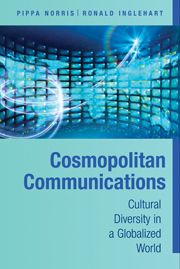Book contents
- Frontmatter
- Contents
- Tables and Figures
- Acknowledgments
- INTRODUCTION
- PART I FIREWALLS
- PART II CONSEQUENCES
- 6 Citizens: National and Cosmopolitan Identities
- 7 Consumers: Economic Values
- 8 Morality: Traditional Values, Sexuality, Gender Equality, and Religiosity
- 9 Activists: Civic Engagement
- CONCLUSIONS
- Technical Appendix A: Concepts and Measures
- Technical Appendix B: List of Countries
- Technical Appendix C: Methods and Multilevel Regression Models
- Notes
- Select Bibliography
- Index
- Titles in the Series
7 - Consumers: Economic Values
Published online by Cambridge University Press: 05 June 2012
- Frontmatter
- Contents
- Tables and Figures
- Acknowledgments
- INTRODUCTION
- PART I FIREWALLS
- PART II CONSEQUENCES
- 6 Citizens: National and Cosmopolitan Identities
- 7 Consumers: Economic Values
- 8 Morality: Traditional Values, Sexuality, Gender Equality, and Religiosity
- 9 Activists: Civic Engagement
- CONCLUSIONS
- Technical Appendix A: Concepts and Measures
- Technical Appendix B: List of Countries
- Technical Appendix C: Methods and Multilevel Regression Models
- Notes
- Select Bibliography
- Index
- Titles in the Series
Summary
A central feature of globalization has been the integration of world markets, binding together the fortunes of Wall Street, the City of London, and the Deutsche Börse; linking call centers in Bangalore with customers in Toronto; and shipping Asian-made goods to American shelves. Indeed, contemporary commentators such as Martin Wolf regard the economics of globalization as the driving force for almost all other aspects of globalization. Improvements in transport and communications have opened new opportunities for commerce; the railway, steamship, and transatlantic telegraph bound economies together in the 19th century, just as container ships, satellite, and the Internet led to faster trade in the 20th. Debate continues about how to interpret economic globalization, including whether what is happening amounts to growing segmentation into major regional trading blocs (principally the European Union, APEC, and NAFTA) rather than growing integration of the entire world. It is also questioned whether contemporary patterns of economic integration are unprecedented or whether earlier historical eras experienced cycles of internationalization that were longer than those of the current period. We have examined rising levels of economic globalization during recent decades: trends in the KOF index illustrated in Figure 4.3 suggest relatively slow growth in economic integration during the 1970s and 1980s, followed by a spurt since the early 1990s. Chapter 4 also showed the persistent globalization gap between rich and poor nations, with the major OECD economies bound together most strongly by intensified flows of capital and trade across national borders, a process also affecting the leading emerging market economies in Europe, Latin America, and East Asia.
- Type
- Chapter
- Information
- Cosmopolitan CommunicationsCultural Diversity in a Globalized World, pp. 199 - 219Publisher: Cambridge University PressPrint publication year: 2009



